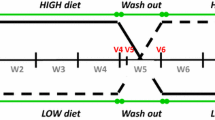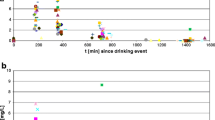Summary
Salsolinol is present in human fluids and tissues as well as in foods and beverages. It was shown previously that the R enantiomer of salsolinol predominates in human urine, whereas the S enantiomer predominates in Port wine. An R/S ratio very near to 1 was found in dried banana, a food particularly rich in salsolinol.
In this study 100 g of dried banana were administered to 6 healthy subjects. The urinary excretion of the R and S enantiomers of salsolinol was measured 24 h before and 24 h after banana intake, each time in two fractions. Whereas the S enantiomer was present only in the fraction 5 p.m.–9 a.m. and only in 3 out of the 6 subjects before banana intake, this enantiomer was found in the two intervals 9 a.m.–5 p.m. and 5 p.m.–9 a.m. in all the subjects after banana intake. The presence of the S enantiomer in urine in 3 subjects before dried banana might be related to alcohol intake. The amount of R + S salsolinol eliminated in the 24 h urine was found to represent 0.75% of the total dose administered. In conclusion a normal diet should have a negligible influence on urinary salsolinol concentrations, with, perhaps, the exception of alcohol; interestingly the R enantiomer might represent endogenous salsolinol.
Similar content being viewed by others
References
Cohen G, Heikkila RE, Dembiec D, Sang D, Teitel S, Brossi A (1974) Pharmacologic activity of stereoisomers of 1-substituted 6,7-dihydroxy-1,2,3,4-tetrahydroisoquinolines: inhibition of3H-dopamine accumulation by rat brain slices and lipolytic activity with isolated mouse fat cells. Eur J Pharmacol 29: 292–297
Collins MA, Hannigan JJ, Origitano T, Moura D, Osswald W (1982) On the occurrence, assay and metabolism of simple tetrahydroisoquinolines in mammalian tissues. Prog Clin Biol Res 90: 155–166
Dordain G, Dostert P, Strolin Benedetti M, Rovei V (1984) Tetrahydroisoquinoline derivatives and Parkinsonism. In: Tipton KF, Dostert P, Strolin Benedetti M (eds) Monoamine oxidase and disease. Prospects for therapy with reversible inhibitors. Academic Press, London, pp 417–426
Dostert P, Strolin Benedetti M, Dedieu M (1987a) Ratio of enantiomers of salsolinol in human urine. Pharmacol Toxicol 60 [Suppl 1]: 13
Dostert P, Strolin Benedetti M, Dedieu M (1987b) Is salsolinol as a racemic mixture in human urine or does an enantiomer predominate? Pharmacol Toxicol 60 [Suppl 1]: 12
Dostert P, Strolin Benedetti M, Dordain G (1988) Dopamine-derived alkaloids in alcoholism and in Parkinson's and Huntington's diseases. J Neural Transm 74: 61–74
Duncan MW, Smythe GA (1982) Salsolinol and dopamine in alcoholic beverages. Lancet i: 904–905
Gal J, Desai DM, Bloedow DC (1986) (S)-1-(naphthyl)ethyl isothiocyanate: a new chiral derivatizing agent in liquid chromatography. In: 10th international symposium on column liquid chromatography, San Francisco, May 18–23, book of abstracts, p 406
Lee OS, Mears JA, Miller DD, Feller DR (1974) Evaluation of the optical isomers of tetrahydroisoquinolines in rat adipose tissue and in guinea pig aorta. Eur J Pharmacol 28: 225–229
North RA, Collins MA, Milner JD, Karras PJ, Koziol DJ (1981) Tetrahydroisoquinolines do not act on opiate receptors in the guinea pig ileum. Eur J Pharmacol 71: 489–493
Pianezzola E, Bellotti V, Fontana E, Gal J, Desai DM, Moro E (in press) Determination of the enantiomeric composition of salsolinol by HPLC with electrochemical detection. J Chromatogr
Smythe GA, Duncan MW (1985) Precise GC/MS assays for salsolinol and tetrahydroisoquinoline: the question of artefacts and dietary sources and the influence of alcohol. Prog Clin Biol Res 183: 77–84
Strolin Benedetti M, Dostert P, Dedieu M (1986) Ratio of enantiomers of salsolinol in human urine and effect of food. In: 15th C.I.N.P. Congress, Puerto Rico, December 14–17, book of abstracts, p 56
Strolin Benedetti M, Bellotti V, Pianezzola E, Moro E, Carminati P, Dostert P (1989) Ratio of the R and S enantiomers of salsolinol in food and human urine. J Neural Transm 77: 47–53
Tampier L, Alpers H, Davis VE (1977) Influence of catecholamine-derived alkaloids and Β-adrenergic blocking agents on stereospecific binding of3H-naloxone. Res Commun Chem Pathol Pharmacol 17: 731–734
Author information
Authors and Affiliations
Rights and permissions
About this article
Cite this article
Strolin Benedetti, M., Dostert, P. & Carminati, P. Influence of food intake on the enantiomeric composition of urinary salsolinol in man. J. Neural Transmission 78, 43–51 (1989). https://doi.org/10.1007/BF01247112
Received:
Accepted:
Issue Date:
DOI: https://doi.org/10.1007/BF01247112




